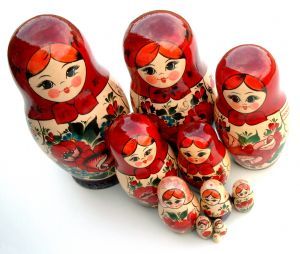Matryoshka Doll History
Matryoshka doll (or Russian nesting or nested doll) is a doll made of wood that can be separated horizontally in half and holds inside another similar but smaller doll that in turn holds another similar smaller doll and so on.
Matryoshkas most commonly have 3 to 12 doll in one set. First matryoska was made in 1890 in time of both social unrest, emerging national identity for Russia and the development of Russian style which idea was to save tradition which was in danger to be lost to time. Matryoshka was made by Vasily Zvyozdochkin, who was turning craftsman and wood carver, from a design by Sergey Malyutin, Russian painter, architect and stage designer. Sergey Malyutin also painted them.
Inspiration for matryoshka came to them from a doll from Honshu, the main island of Japan but it is not certain which type. Some sources say that it was daruma doll while other say it was fukuruma nesting doll. Nesting toys are an idea that is thousand years old and they came from China. They were nesting boxes and they dated back to the Song Dynasty, around 1000 AD.

In 18th century idea of nesting was implemented on dolls. Matryoshka doll was presented to the world for the first time in 1900 on "Exposition Universelle", world's fair held in Paris, where it earned the bronze medal. After that, matryoshka dolls gained popularity and were being made in many places in Russia and shipped around the world. Dolls are made from lime, birch aspen or alder from the smallest doll to the largest. When finished, dolls are hand painted with gouache, a type of heavier watercolor. This paint is made by mixing dry pigment with water and gum which gives thickness to the paint.
Matryoshka dolls of one set are often designed to have one theme and traditional ones are painted to resemble peasant girls in traditional dress - "sarafan" which is Russian peasant jumper dress.
All matryoshkas are basically of the same cylindrical shape but can be painted differently. Each doll of one set is similar but different. They can differ in color, facial expressions, things that they hold in hands (like bread, salt, and basket of fruits or vegetables) or design of the clothes.
Today designs of matryoshkas have a wide range of designs and modern matryoskas are painted in many different styles, from fairy tale characters to politicians including floral, religious, likenesses of famous persons, real or imaginary and even national landmarks. One of the most common themes during Perestroika were Russian leaders. The largest matryoska was painted in the likeness of Mikhail Gorbachev, next one, smaller like Leonid Brezhnev, then Nikita Khrushchev, Josef Stalin and finally the smallest, Vladimir Lenin. Modern ones start with Dmitry Medvedev and Vladimir Putin and can end with the smallest matryoska painted like Emperor Nicholas II. Some matryoshkas are painted to look like household pets. Dog usually the largest and inner dolls are painted as a cat, bird, fish, and mouse as a smallest doll.


